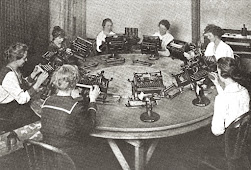The concept of a typewriter existed long before the first typewriters as we view them were produced. In 1575, Francesco Rampazetto created the 'Scrittura Tattile', a machine that impressed letters on to paper. A little later, in 1808, Pelligrino Turri created a machine for his blind friend to use in place of handwriting. In 1829 William Austin Burt created a 'Typographer' that never found success due to its slow pace and unpractical size. These early on attempts show that people saw a need for a replacement to handwriting. These are just a few examples out of the 112 machines similar to the typewriter created before 1867.
In 1867, Christopher Latham Sholes constructed the first practical typewriter. After improvements to make the machine quicker and more functional, "The Remington" was placed on the market in 1874. The typewriter was created to be a faster mechanism for documentation of words than handwriting, so when this first model still seemed a bit slow and only wrote capital letters, "The Remington 2" came out with a shift-key addition, which made the resemblance of handwriting more accurate. This second model was placed on the market in 1878. In 1882 1,400 were sold, but by 1887, 14,000 typewriters had been sold.
In 1972, Thomas Edison Created the first electrical typewriter. This new style continued too add to the sought after quickness and efficiency of the machines, the only issue was its lack of portability due to its need for electricity - hence the 'electrical' in the title. In 1909 portable typewriters joined the market and by 1950 portable was the way to go. Knowing the reason typewriters were made helps to know why portability was important.
As made clear through the extensive history of machines that resemble the typewriter we know today, past generations saw a need for a swift and simple substitute for handwriting. Because handwriting varied by the hand doing it, whether that in looks or speed, the typewriter provided a consistent look easy for anyone to read, and an opportunity for speed. The ultimate goal of the practical typewriter was to type faster than a person could write, and it was successful in doing that.
This quick writing, beginning to be known as typing, was useful for business and pleasure. It's impact to the world of office work was major, especially for women during the time of its creation. In a post-civil war America women began to enter the workforce due to the loss of numerous men during war. By 1890, 64% of all typists were women. The typewriter gave women a job opportunity in something other than a teacher, and quickly became a symbol for their entrance into office work.
The typewriter began to fade in sales by the 1980s when the word processor entered the market. While the machine couldn't keep up in efficiency, simplicity, or portability, its impact on our world today is not to be forgotten. Think of how often you spend your day typing away, whether its on a phone screen or a computer, the action of typing began with the typewriter. The assortment of the keys even stems from it, seeing that most electronics use a QWERTY setup, just as the typewriter did. Of course, some people still use the typewriter for pleasure, or own them just for looks. You can find them on Ebay, or at antique stores, new or old. Even though they may not have a spotlight on the market, the typewriter had a major impact on the world of communication as we know it.




No comments:
Post a Comment